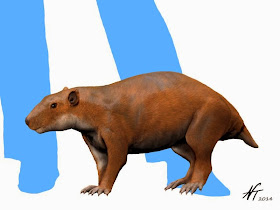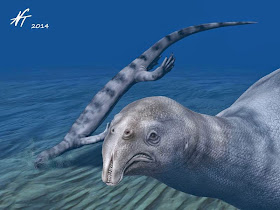Here are my picks for the top paleontology stories of year 2014 (not in particular order):
1) Fossilized pigments show mesozoic marine reptiles in their true colors.
 |
| Tylosaurus nepaeolicus |
2) Copulation and internal fertilization have appeared 385 millions years ago in primitive armored fish adding a big step to our understanding of the evolution of sex in our distant ancestors.
Ref: Long, J. A., Mark-Kurik, E., Johanson, Z., Lee, M. S., Young, G. C., Min, Z., ... & Trinajstic, K. (2014). Copulation in antiarch placoderms and the origin of gnathostome internal fertilization. Nature. Published online
3) New fossils of the cambrian chordate Metaspriggina walcotti show that it was an early very primitive fish.
 |
| Metaspriggina walcotti |
4) Exceptionally well preserved fossilized eye tissues of a 300 millions years old spiny shark, Acanthodes bridgei, shows it had color vision.
 |
| Acanthodes sp. |
5) Spinosaurus was an odd-looking semi-aquatic predator that might have walked on all four.
Ref: Ibrahim, N., Sereno, P. C., Dal Sasso, C., Maganuco, S., Fabbri, M., Martill, D. M., ... & Iurino, D. A. (2014). Semiaquatic adaptations in a giant predatory dinosaur. Science, 345(6204), 1613-1616.
 |
| Deinocheirus mirificus |
 |
| Spinosaurus aegyptiacus |
Ref: Lee, Y. N., Barsbold, R., Currie, P. J., Kobayashi, Y., Lee, H. J., Godefroit, P., ... & Chinzorig, T. (2014). Resolving the long-standing enigmas of a giant ornithomimosaur Deinocheirus mirificus. Nature. 515, 257–260.
 |
| Dreadnoughtus schrani |
7) Dreadnoughtus schrani, one of the largest dinosaurs and the most complete skeleton of a titanosaur to have been discovered to date.
Ref: Lacovara, K. J., Lamanna, M. C., Ibiricu, L. M., Poole, J. C., Schroeter, E. R., Ullmann, P. V., ... & Novas, F. E. (2014). A Gigantic, Exceptionally Complete Titanosaurian Sauropod Dinosaur from Southern Patagonia, Argentina. Scientific reports, 4, 6196.
 |
| Kulindadromeus zabaikalicus |
8) The discovery of the feathered ornithischian Kulindadromeus zabaikalicus, suggests that the earliest dinosaurs probably also sported feathers.
Ref: Godefroit, P., Sinitsa, S. M., Dhouailly, D., Bolotsky, Y. L., Sizov, A. V., McNamara, M. E., ... & Spagna, P. (2014). A Jurassic ornithischian dinosaur from Siberia with both feathers and scales. Science, 345(6195), 451-455.
 |
| Vintana sertichi |
Ref: Krause, D. W., Hoffmann, S., Wible, J. R., Kirk, E. C., Schultz, J. A., von Koenigswald, W., ... & Andriamialison, H. (2014). First cranial remains of a gondwanatherian mammal reveal remarkable mosaicism. Nature, 515(7528), 512-517.
 |
| Atopodentatus unicus |
10.- Atopodentatus unicus is probably one of the strangest vertebrate fossil ever found.
Ref: Cheng, L., Chen, X. H., Shang, Q. H., & Wu, X. C. (2014). A new marine reptile from the Triassic of China, with a highly specialized feeding adaptation. Naturwissenschaften, 101(3), 251-259.
 |
| Semirostrum cerrutii |
11.- A fossil porpoise, Semirostrum cerrutii, reveals unique skim feeding habit.
Ref: Racicot, R. A., Deméré, T. A., Beatty, B. L., & Boessenecker, R. W. (2014). Unique Feeding Morphology in a New Prognathous Extinct Porpoise from the Pliocene of California. Current Biology, 24(7), 774-779.
12.- A massive genomic analysis on 44 species of birds representing all extant orders resolves bird tree-of-life and ancestry. Chickens and turkeys, it turns out, were found to be more closer to their dinosaur ancestors than any other birds.
Ref: Jarvis, E. D., Mirarab, S., Aberer, A. J., Li, B., Houde, P., Li, C., ... & Samaniego, J. A. (2014). Whole-genome analyses resolve early branches in the tree of life of modern birds. Science, 346(6215), 1320-1331.








